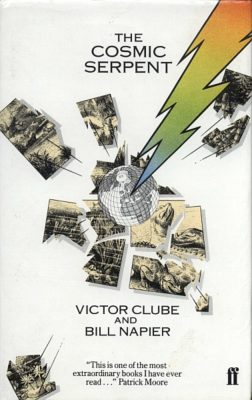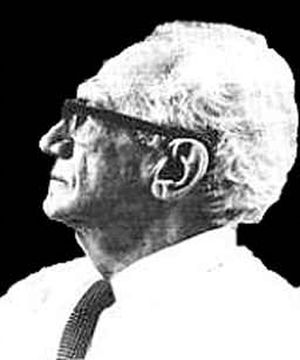Dr Stace Victor Murray Clube (S.V.M. Clube) (born October 22, 1934 in London) is a British astrophysicist, previously Dean of the astrophysics department at Oxford University. Together with Bill Napier is co-author of books on coherent catastrophism, and also with Mark Bailey. He has also been Senior Visiting Fellow at Armagh Observatory, and Acting Director of the Royal Observatory in Edinburgh. In the late 1950s he played first class cricket for Oxford University.[1]EPSN: CricInfo “Stace Clube“
Coherent catastrophism
In their book, The Cosmic Serpent, Clube and Napier write:
“In this book we bring together hitherto unconnected strands in astronomy, biology and geology, and in the early history and mythology of man.
“The unifying theme is the comet, currently thought of as a minor actor in the cosmic drama. We shall propose that it grows out of the cold, dense nebulae found in interstellar space; is captured into the solar system during a close encounter; and if not flung out again, is thrown either into the space between Mars and Jupiter where it becomes an asteroid, or into an orbit which will bring it eventually, in the form of an asteroid, into collision witha planet.”[2]Victor Clube and Bill Napier, The Cosmic Serpent, Publ. 1982 Faber and Faber. ISBN: 0-571-11816-X

Geologist Derek Ager writes:
“Victor Clube suggested (1978) that our galaxy had a violent history and later he and Bill Napier argued for a theory of terrestrial catastrophism which really started the recent interest in asteroid impacts on the Earth (Napier & Clube 1979). Later they produced a remarkable book (1982) which was subtitled A catastrophist view of Earth History presenting a convincing argument for a giant comet that terrorized mankind in prehistoric rinses. They put together a great deal of evidence from a variety of sources that speaks of a violent past and a hazardous future.”[3]Derek Ager, The new catastrophism: the importance of the rare event in geological history Cambridge University Press, 1995, ISBN: 0521483581 (page 180)
Clube et al have developed their theory of “coherent catastrophism“. Prof. Trevor Palmer writes:
“Nevertheless, whilst rejecting almost every aspect of Velikovsky‘s hypothesis, astronomers accept that a large cosmic body could pass close to the Earth and cause catastrophes. In particular, the Earth may be under threat from giant comets which, although small in comparison to planets, are very much bigger than the comets that are normally seen. That view has been developed mainly by British astronomers, including Victor Clube together with Bill Napier and Mark Bailey of the Armagh Observatory, Duncan Steel of Salford University (and formerly of Spaceguard Australia) and David Asher of Oxford University and the Communications Research Laboratory, Japan.[4]Trevor Palmer, Perilous planet earth: catastrophes and catastrophism through the ages, Published by Cambridge University Press, 2003, ISBN 0521819288, 522 pages. (page 206-207)
Comparison with Velikovsky
Bruce Lerro writes:
“Scientific catastrophists, such as Clube, Napier, and Steel, agree with Velikovsky that there were disruptions in the ancient skies — but they attribute these disruptions to comets and/or asteroids and not to other planets.”[5]Bruce Lerro, Power in Eden: The Emergence of Gender Hierarchies in the Ancient World, Published by Trafford Publishing, 2005, ISBN 1412021413, 418 pages (page 253) ..
“Astronomers Clube and Napier distinguish their “neo-catastrophism” — or “coherent catastrophism” — from earlier catastrophist theories in several ways. Unlike Ignatius Donnelly and Immanuel Velikovsky, whose popular books in the later nineteenth and mid-twentieth centuries appeal to wide audiences, Clube and Napier do not suggest that comet or asteroid directly impacted the Earth during human history. Instead they argue that a huge comet (100 km) circulated through the solar system several thousand years ago, and the Earth periodically passed through its train of debris. Clube and Napier do not argue that the impact of this debris was always global in scope. Damage from impacts would have varied in magnitude depending on the size of the debris and where the objects hit (land or sea). Thus some of the resulting catastrophes would have been local, some regional, and some global.”[6]Bruce Lerro, Power in Eden: The Emergence of Gender Hierarchies in the Ancient World, Published by Trafford Publishing, 2005, ISBN 1412021413, 418 pages (page 212)
Selected bibliography
Books
- The Cosmic Serpent (1982), with Bill Napier ISBN: 0-571-11816-X
- The Cosmic Winter (1990), with Bill Napier
- The Origin of Comets (1990), with M. E. Bailey and Bill Napier
- Catastrophes and Evolution: Astronomical Foundations, (Editor), Cambridge University Press (29 Jun 1990), ISBN: 0521374200. Includes paper: “The catastrophic role of giant comets“
- Catastrophes and Comets: The Destroyers of Cosmic Faith (World Scientific Series in Astronomy and Astrophysics, Vol 3), (Nov 2004) with Bill Napier ISBN: 981023015X
Papers
- “Does our Galaxy have a violent history“, Clube, S. V. M., Vistas in Astronomy, vol. 22, pt. 1, 1978, p. 77-118.
- “A theory of terrestrial catastrophism“, W.M. Napier, S.V.M.Clube, Nature 282, 455 – 459 (29 November 1979)
- “The role of episodic bombardment in geophysics“, Clube, S. V. M.; Napier, W. M., Earth and Planetary Science Letters, vol. 57, no. 2, Feb. 1982, p. 251-262.
- “Spiral Arms, Comets and Terrestrial Catastrophism“, Clube, S. V. M.; Napier, W. M., Quarterly Journal of the Royal Astronomical Society, March 1983, vol. 23, 45-66 (Full text)
- “The Microstructure of Terrestrial Catastrophism” (1984). Royal Astronomical Society, Monthly Notices 211, 953-968, with W.M. Napier (Full text)
- “Comet capture from molecular clouds – A dynamical constraint on star and planet formation“, Clube, S. V. M.; Napier, W. M., Royal Astronomical Society, Monthly Notices (ISSN 0035-8711), vol. 208, June 1, 1984, p. 575-588 (Full text)
- “Terrestrial catastrophism – Nemesis or Galaxy?“, Clube, S. V. M.; Napier, W. M., Nature (ISSN 0028-0836), vol. 311, Oct. 18, 1984, p. 635, 636.
- “Cosmological Redshifts and the Law of Corresponding States“, Frontiers of Fundamental Physics, Proceedings of an International Conference held 27-30 September, 1993 in Olympia, Greece. Edited by Michele Barone and Franco Selleri. New York: Plenum Press, 1984., p.107
- “The origin of comets“, Bailey, M. E.; Clube, S. V. M.; Napier, W. M., Vistas in Astronomy (ISSN 0083-6656), vol. 29, pt. 1, 1986, p. 53-112.
- “Giant comets and the Galaxy – Implications of the terrestrial record“, Clube, S. V. M.; Napier, W. M., The galaxy and the solar system (A87-34101 14-90). Tucson, AZ, University of Arizona Press, 1986, p. 260-285.
- “The cometary breakup hypothesis re-examined – A reply“, Clube, S. V. M.; Napier, W. M., Royal Astronomical Society, Monthly Notices (ISSN 0035-8711), vol. 225, April 1, 1987, p. 55P-58P (Full text)
- The dynamics of armageddon (1988). Speculations of Science and Technology 11 (4), 255-264; reprinted in Zysman, Milton and Clark Whelton (eds.) (1990). Catastrophism 2000: A Sourcebook for the Conference Reconsidering Velikovsky, Toronto, Canada, pp. 5-16.
- Giant Comets and Their Role in History, Chapter 14 in Singer, S. Fred (ed.) (1990). The Universe and Its Origin: From Ancient Myth to Present Reality and Fantasy, Paragon House, New York. ISBN: 0-89226-049-1, pp. 145-161.
- “The structure and evolution of the Taurid Complex” (1991). Mon. Not. R. astr. Soc. 251, 632-648, with D.I. Steel and D.J. Asher. (Full text)
- The Fundamental Role of Giant Comets in Earth History (1992). Celestial Mechanics and Dynamical Astronomy 54, 179-193. (Full text)
- “Asteroids in the Taurid Complex“, Asher, D. J.; Clube, S. V. M.; Steel, D. I., Royal Astronomical Society, Monthly Notices, Sept 1993, p. 93, 1993 (Full text)
- Hazards from Space: Comets in History and Science (1994). Chapter 7 in Glen, William (ed.) (1994). The Mass-extinction Debates: How Science Works in a Crisis, Stanford University Press. ISBN 0804722854. pp. 152-169.
- “Coherent catastrophism“, Asher, D. J.; Clube, S. V. M.; Napier, W. M.; Steel, D. I., Vistas in Astronomy, vol. 38, Issue 1, pp.1-27
- “An Extraterrestrial Influence during the Current Glacial-Interglacial“, Asher, D. J.; Clube, S. V. M., Quarterly Journal of the Royal Astronomical Society (1993), p. 481-511 (Full text)
- Are Impacts Correlated in Time? (1994). In Gehrels, Tom (ed.) (1994). Hazards Due to Comets and Asteroids, University of Arizona Press. ISBN 0816515050. pp. 463-478; with D.I. Steel, D.J. Asher and W.M. Napier.
- The Nature of Punctuational Crises and the Spenglerian Model of Civilization (1995). Vistas in Astronomy 39, 673-698.http://www.sott.net/articles/show/147270-The-Nature-of-Punctuational-Crises-and-the-Spenglerian-Model-of-Civilization
- “The calendar and the Holocene” with D.J. Asher, Conference proceedings, Environmental Catastrophes and Recoveries in the Holocene, August 29 – September 2, 2002
- An Exceptional Cosmic Influence and its Bearing on the Evolution of Human Culture as Evident in the Apparent Early Development of Mathematics and Astronomy (2003). Astrophysics and Space Science 285, 521-532.
Articles
- Close encounters with a million comets (15 July 1982). New Scientist 95, (1314), 148-151, with Bill Napier
References
| ↑1 | EPSN: CricInfo “Stace Clube“ |
|---|---|
| ↑2 | Victor Clube and Bill Napier, The Cosmic Serpent, Publ. 1982 Faber and Faber. ISBN: 0-571-11816-X |
| ↑3 | Derek Ager, The new catastrophism: the importance of the rare event in geological history Cambridge University Press, 1995, ISBN: 0521483581 (page 180) |
| ↑4 | Trevor Palmer, Perilous planet earth: catastrophes and catastrophism through the ages, Published by Cambridge University Press, 2003, ISBN 0521819288, 522 pages. (page 206-207) |
| ↑5 | Bruce Lerro, Power in Eden: The Emergence of Gender Hierarchies in the Ancient World, Published by Trafford Publishing, 2005, ISBN 1412021413, 418 pages (page 253) |
| ↑6 | Bruce Lerro, Power in Eden: The Emergence of Gender Hierarchies in the Ancient World, Published by Trafford Publishing, 2005, ISBN 1412021413, 418 pages (page 212) |

